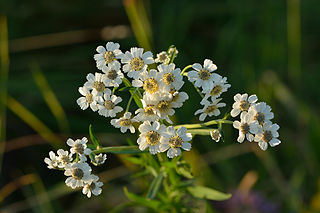
Lamium (dead-nettles) is a genus of about 30 species of flowering plants in the family Lamiaceae, of which it is the type genus. They are all herbaceous plants native to Europe, Asia, and northern Africa, but several have become very successful weeds of crop fields and are now widely naturalised across much of the temperate world.

Achillea ptarmica is a European species of herbaceous perennial flowering plant in the genus Achillea of the daisy family Asteraceae. Common names include the sneezewort, sneezeweed, bastard pellitory, European pellitory, fair-maid-of-France, goose tongue, sneezewort yarrow, wild pellitory, and white tansy. It is widespread across most of Europe and naturalized in scattered places in North America. It is native to Europe and western Asia.

Prunella is a genus of herbaceous plants in the family Lamiaceae, also known as self-heals, heal-all, or allheal for their use in herbal medicine.

Rubus phoenicolasius is an Asian species of raspberry in the rose family, native to China, Japan, and Korea.

Monarda didyma, the crimson beebalm, scarlet beebalm, scarlet monarda, Eau-de-Cologne plant, Oswego tea, or bergamot, is a North American aromatic herb in the family Lamiaceae.

The golden samphire is a perennial coastal species, which may be found growing on salt marsh or sea cliffs across western and southern Europe and the Mediterranean.

Stylophorum diphyllum, commonly called the celandine poppy or wood poppy, is an herbaceous plant in the poppy family (Papaveraceae). It is native to North America, where it is found in the eastern United States and Ontario. Its typical natural habitat is moist forests over calcareous rock, particularly in ravines.

Uludağ, the ancient Mysian or Bithynian Olympus, is a mountain in Bursa Province, Turkey, with an elevation of 2,543 m (8,343 ft).

Doronicum is a genus of flowering plants in the sunflower family, known as leopard's bane. They are all herbaceous perennials native to Europe, southwest Asia and Siberia. They produce yellow, daisy-like flowerheads in spring and summer.

Eupatorium cannabinum, commonly known as hemp-agrimony, or holy rope, is a herbaceous plant in the family Asteraceae. It is a robust perennial native to Europe, NW. Africa, Turkey, Syria, Iran, Iraq, Jordan, the Caucasus and Central Asia. It is cultivated as an ornamental and occasionally found as a garden escape in scattered locations in China, the United States and Canada. It is extremely attractive to butterflies, much like buddleia.
Leopard's bane or leopard's-bane may refer to:

Doronicum grandiflorum is a European species of Doronicum, a member of the family Asteraceae.

Achillea nobilis, the noble yarrow, is a flowering plant in the sunflower family. It is native to Eurasia, widespread across most of Europe and also present in Turkey, the Caucasus, and Central Asia. It is reportedly present in Xinjiang Province in western China, but this is based on a single herbarium specimen collected in the 19th century. The species is widely cultivated and has become naturalized outside of its range in North America and other parts of the world.

The term bane, in botany, is an archaic element in the common names of plants known to be toxic or poisonous.

Cirsium heterophyllum, the melancholy thistle, is an erect spineless herbaceous perennial flowering plant in the family Asteraceae. It is native to Europe and western Asia, where it grows in upland meadows, grasslands, road verges and open woodland.

Arnica chamissonis, the Chamisso arnica, is a North American species of plants in the family Asteraceae. It is very similar to Arnica montana. Arnica chamissonis is native to North America and naturalized in parts of Europe while A. montana is indigenous to Europe.

Angelica palustris, commonly known as marsh angelica, is a biennial or a perennial plant species from the family Apiaceae.

Doronicum plantagineum, the plantain-leaved leopard's-bane or plantain false leopardbane, is a European plant species in the sunflower family. It is native to southeastern Europe from Greece and Italy to Ukraine and the Czech Republic. There are reports of the species being naturalized in the State of Oregon in the northwestern United States.

Doronicum pardalianches, known as leopard's-bane, is a species of flowering plant in the family Asteraceae. Like other members of the genus Doronicum, it is a rhizomatous herbaceous perennial. It has upright stems growing to 80 cm (31 in), with heart-shaped basal leaves and yellow flowers, generally 3–4.5 cm (1.2–1.8 in) across. It is native to western Europe and was introduced to the British Isles, where it was first recorded in Northumberland in 1633.

Doronicum austriacum, the Austrian leopard's bane, is a species of flowering plant in the family Asteraceae. It is native to Europe and Turkey, and prefers to grow in beech and spruce forests. A clumping perennial reaching 120 cm (47 in), it is available from commercial suppliers, with the Royal Horticultural Society considering it to be a good plant to attract pollinators.



















